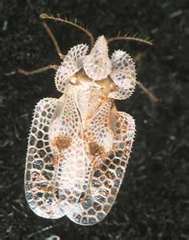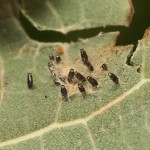Lace bugs can be divided into two groups:
- Those that attack deciduous trees and shrubs
- Those that attack evergreen shrubs
Often the leaf damage resembles that of mites. Examining the underside of the leaf will help to determine the insect doing the damage. Lace bugs produce a dark, varnish-like excrement that sticks to the leaf. The presents of live lace bugs, “skins” shed from molted nymphs, or eggs may be present as well.
Did you know that:
- They get their name from the lace-like wings of the adults.
- There are about 160 species of lace bugs.
- Lace bugs are host specific – feeding on one plant, or a closely related plant species.
- Females lay their eggs along the veins on the underside of the leaf.
- Nymphs start out wingless and colorless and often have spines.
- Lace bugs develop through 5 stages, which occur over approximately 30 days.
- Adult lace bugs are 1/8″ – 1/4″ long.
- All stages can be found together on the underside of the leaf.
- They damage plants by piercing the leaf and sucking the juices out of it.
- Signs on damage appear as discoloring spots on the upper leaf.
- Plants in hot, sunny locations are more susceptible to lace bug damage.
Sterling Is The Solution (207) 767-5555









